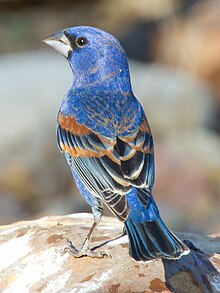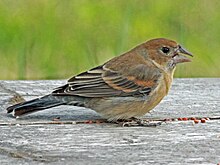Blue grosbeak
| Blue grosbeak | |
|---|---|

| |
| Adult male | |

| |
| Adult female | |
| Scientific classification | |
| Domain: | Eukaryota |
| Kingdom: | Animalia |
| Phylum: | Chordata |
| Class: | Aves |
| Order: | Passeriformes |
| Family: | Cardinalidae |
| Genus: | Passerina |
| Species: | P. caerulea
|
| Binomial name | |
| Passerina caerulea | |

| |
Breeding
Migration
Year-round
Nonbreeding
| |
| Synonyms | |
| |
The blue grosbeak (Passerina caerulea), is a medium-sized North American passerine bird in the cardinal family Cardinalidae. It is mainly migratory, wintering in Central America and breeding in northern Mexico and the southern United States. The male is blue with two brown wing bars. The female is mainly brown with scattered blue feathers on the upperparts and two brown wing bars.
Taxonomy
The blue grosbeak was
Some taxonomists placed the blue grosbeak in its own
Seven subspecies are recognised:[8]
- P. c. caerulea (Linnaeus, 1758) – southeast and south central USA
- P. c. interfusa (Dwight & Griscom, 1927) – west central USA and north Mexico
- P. c. salicaria (Grinnell, 1911) – southwest USA and northwest Mexico
- P. c. eurhyncha (Coues, 1874) – central and south Mexico
- P. c. chiapensis (Nelson, 1898) – south Mexico to Guatemala
- P. c. deltarhyncha (Van Rossem, 1938) – west Mexico
- P. c. lazula (Lesson, R, 1842) – south Guatemala to northwest Costa Rica
Description
The male blue grosbeak is deep blue, with both black and brown on its wings. The female is mostly brown. Both sexes are distinguished by their large, deep bill and double wing bars. These features, as well as the grosbeak's relatively larger size, distinguish this species from the indigo bunting. Length can range from 14 to 19 cm (5.5 to 7.5 in) and wingspan is from 26 to 29 cm (10 to 11 in).[9][10] Body mass is typically from 26 to 31.5 g (0.92 to 1.11 oz).[11]
Distribution and habitat
This is a migratory bird, with nesting grounds across most of the southern half of the United States and much of northern Mexico, migrating south to Central America and in very small numbers to northern South America; the southernmost record comes from eastern Ecuador.
This species is found in partly open habitat with scattered trees, riparian woodland, scrub, thickets, cultivated lands, woodland edges, overgrown fields, or hedgerows.
Behaviour and ecology
Breeding
The blue grosbeak nests in a low tree or bush or a tangle of vegetation, usually about 1–2.5 m (3.3–8.2 ft) above ground, often at the edge of an open area.[12]
Feeding
It eats mostly insects, but it will also eat snails, spiders, seeds, grains, and wild fruits. The blue grosbeak forages mainly on the ground.[13]
Gallery
-
Male (upper), female (lower)
-
Blue Grosbeak in Birds of America
-
Immature male with partially blue face and tail
References
- . Retrieved 13 November 2021.
- ^ Linnaeus, Carl (1758). Systema Naturae per regna tria naturae, secundum classes, ordines, genera, species, cum characteribus, differentiis, synonymis, locis (in Latin). Vol. 1 (10th ed.). Holmiae (Stockholm): Laurentii Salvii. p. 175.
- ISBN 978-1-4081-2501-4.
- ^ Catesby, Mark (1729–1732). The Natural History of Carolina, Florida and the Bahama Islands (in English and French). Vol. 1. London: W. Innys and R. Manby. p. 39, Plate 39.
- ^ Paynter, Raymond A. Jr, ed. (1970). Check-List of Birds of the World. Vol. 13. Cambridge, Massachusetts: Museum of Comparative Zoology. p. 241.
- .
- ^ Vieillot, Louis Pierre (1816). Analyse d'une Nouvelle Ornithologie Élémentaire (in French). Paris: Deterville/self. p. 30.
- ^ Rasmussen, Pamela, eds. (2020). "Cardinals, grosbeaks and (tanager) allies". IOC World Bird List Version 10.2. International Ornithologists' Union. Retrieved 24 September 2020.
- ^ "Blue Grosbeak".
- ^ "eNature: FieldGuides: Species Detail". Archived from the original on 2012-02-22.
- ISBN 978-0849342585.
- .
- . Retrieved 25 September 2020.




